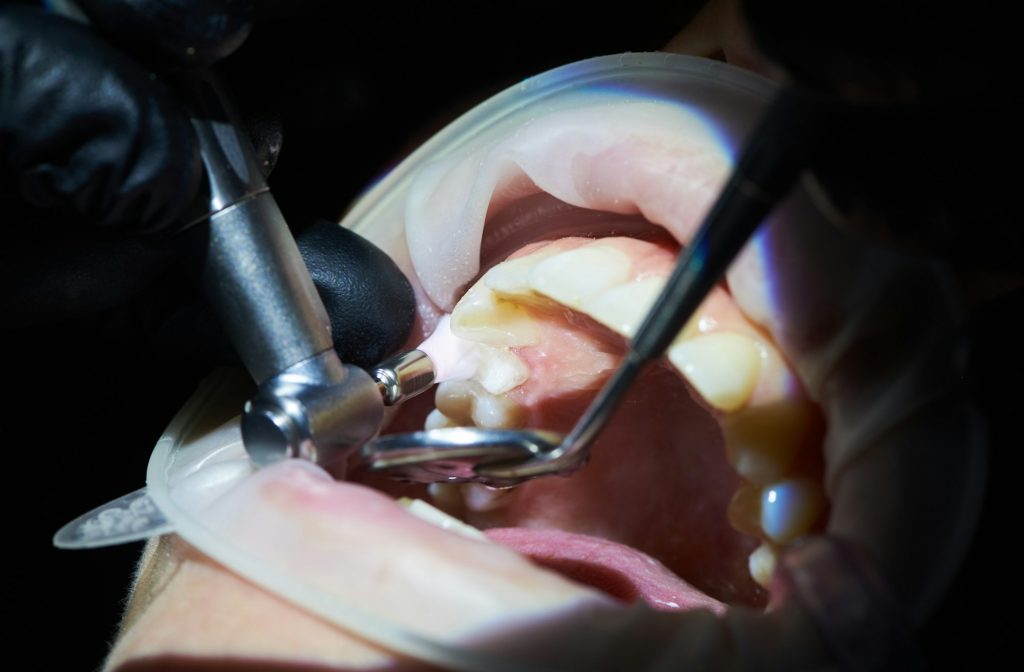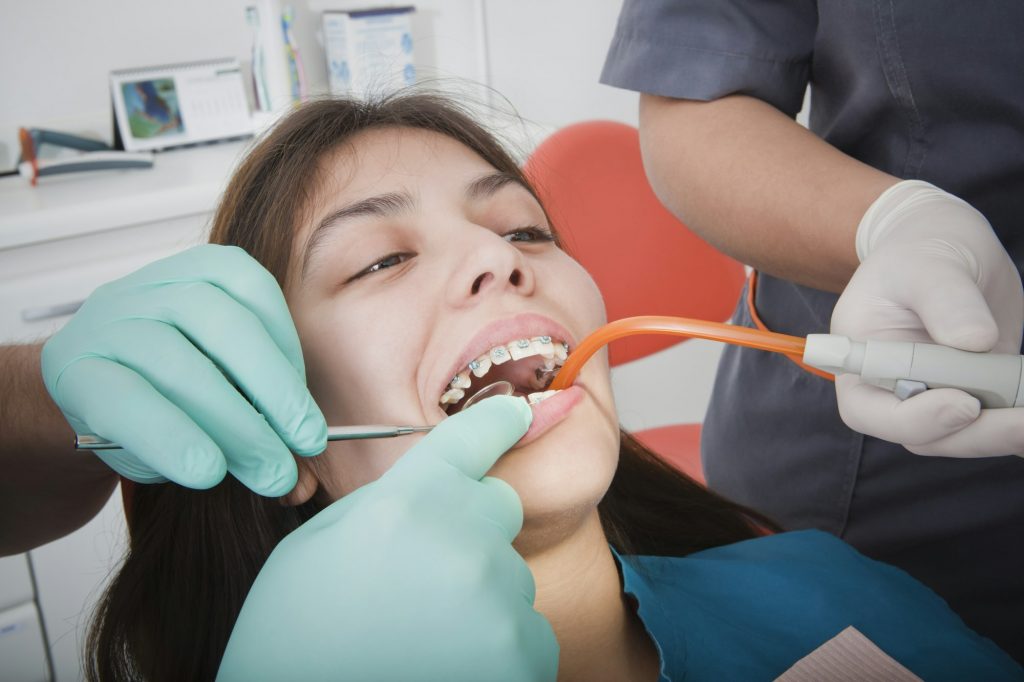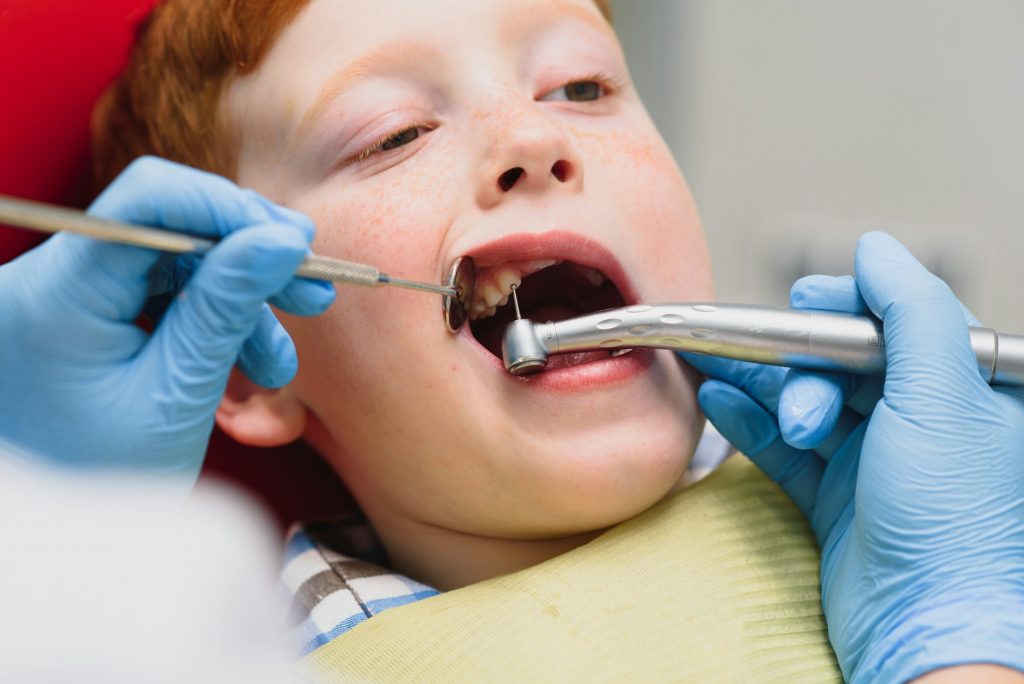Services
Explore Our Services in Detail
Cosmetic Dentistry

Aesthetic dentistry is a branch of dentistry that focuses on improving the appearance of teeth, gums, and the smile overall. Aesthetic dental treatments include a variety of procedures and techniques that can enhance the color, shape, size, position, and alignment of teeth. Let's look at some of the most common treatments in aesthetic dentistry:
Common Aesthetic Dentistry Treatments
Teeth Whitening
Professional Teeth Whitening: It is performed in the dental office using powerful whitening agents and special lighting or laser.
At-home Whitening: With the use of special trays and whitening gel provided by the dentist.
Porcelain Veneers
Thin coverings made of porcelain or composite resin material that are placed on the front surface of teeth to improve their appearance. They are particularly effective for correcting color imperfections, broken teeth, or gaps between teeth.
Crowns
Porcelain or other material crowns that cover the entire tooth, providing strength and aesthetic improvement, especially for teeth that have undergone severe decay or restorations.
Dental Implants
Permanent substitutes for missing teeth, surgically placed into the jawbone and function as a base for artificial teeth (crowns or bridges).
Orthodontics
It corrects the position of teeth and jaws using braces, clear aligners (such as Invisalign), and other devices, improving the aesthetics and function of the mouth.
Restoration of Broken Teeth
Composite materials or porcelain are used for the reconstruction and reinforcement of broken or worn teeth.
Gum Surgery
A procedure that corrects the gum line for aesthetic improvement or to address issues such as excessive gum growth (gummy smile).
Tips for Aesthetic Dentistry
Consult your dentist: Before deciding on any cosmetic treatment, it's important to consult with a specialist to assess your needs and recommend the appropriate treatment.
Conservative Approaches: When possible, prefer conservative treatments that preserve as much of your natural tooth structure as possible.
Long-Term Care: Maintain the results of aesthetic treatments with good oral hygiene, regular visits to the dentist, and avoiding harmful habits such as smoking and excessive coffee consumption.
Aesthetic dentistry can offer impressive results, enhancing the appearance of your smile and boosting self-confidence. Depending on your personal needs and preferences, your dentist can help you choose the most suitable treatments to achieve the smile you desire.
Prosthetic Dentistry

Cosmetic dentistry is a specialized branch of dentistry that focuses on improving the appearance of teeth, gums, and the smile overall, using various techniques and materials. The goal of cosmetic dentistry is to provide patients with a healthy, natural, and pleasing smile by eliminating any imperfections or irregularities in the appearance of their teeth.
Services provided by a cosmetic dentist include:
Crowns and Veneers: These restorations are placed on damaged or weakened teeth to protect them or to replace lost parts.
Dental Implants: These small artificial teeth are placed in the jaw and act as substitutes for missing teeth.
Aesthetic Restorations: Using porcelain, ceramics, or composite materials, the cosmetic dentist can create natural and beautiful smiles.
Teeth Whitening: Through professional treatments or dental products, cosmetic dentistry can improve the color and whiteness of teeth.
Tooth Alignment: Through orthodontic treatments such as braces or clear aligners, the cosmetic dentist can correct the alignment of teeth for a straighter smile.
Overall, cosmetic dentistry is a significant branch of dentistry aimed at improving the appearance and function of the mouth, offering patients a healthy and natural smile.
Teeth whitening

Teeth whitening is a cosmetic procedure aimed at improving the appearance of teeth by making them whiter and brighter. There are various methods to achieve this, both through professional treatments and products that can be used at home. Let's take a look at the main methods:
Professional Whitening Treatments
Professional In-Office Whitening: This procedure involves the application of a strong whitening agent (usually hydrogen peroxide or carbamide peroxide) by the dentist. Special lighting or laser is often used to activate the whitening agent and accelerate the process.
At-home teeth whitening: The dentist provides special trays and whitening gel for use at home. These trays are custom-made to fit perfectly on the patient's teeth, ensuring uniform application of the whitening agent.
Whitening Products for Home Use
Whitening Strips: Whitening strips" are thin, flexible strips that contain a whitening agent. They are applied to the teeth for a specific period each day for several weeks.
Whitening gel and pens: These products contain a whitening agent that is applied directly to the teeth with a brush or pen.
Whitening toothpaste: They contain mild abrasives and chemicals that remove surface stains. They do not change the natural color of the teeth but can remove stains from coffee, tea, and tobacco.
General Dentistry

General dentistry is the primary branch of dentistry that focuses on the diagnosis, prevention, and treatment of health problems related to the mouth, teeth, gums, and associated structures. The general dentist is typically the first point of contact for patients seeking routine oral care.
The services offered by a general dentist include:
Regular Visits and Cleaning: These visits include checking the condition of the teeth and gums, removing plaque and tartar, and reinforcing oral hygiene.
Cavity Restoration: The removal of cavities and filling of the resulting voids with sealants or restorations.
Dental Restorations: Adding amalgam, composite, or porcelain materials to restore damaged or loose teeth.
Injuries and Extent: Management of Injuries and Extent, such as broken or loose teeth, and providing assistance in cases of dental trauma.
Dental Prevention: Tips for good oral hygiene, including proper toothbrushing and flossing techniques, as well as education on diet and habits that impact oral health.
Tooth Extractions: Need for tooth extractions in cases such as extensive cavities, impactions, or the need for space for orthodontic treatment.
The general dentist serves as the cornerstone of oral health, providing the basic services and care needed by patients to maintain a healthy mouth and teeth.
Dental implants

Dental implants are one of the most advanced technologies in dentistry and provide a permanent solution for replacing missing teeth. These implants are made from materials such as titanium, which are compatible with the body and are integrated into the jawbone or jaw to serve as a support for artificial teeth.
Let's look at the basic facts about dental implants:
Implant Procedure: The implant procedure involves placing the implant into the jawbone through surgery. After placement, the implant integrates with the bone and gains stability.
Types of Implants: There are various types of implants depending on the patient's needs, the type of tooth loss, and the amount and quality of the available bone. These include single implants, bridge implants, and even multiple implants to support dental bridges or full dentures.
Adjustment of Artificial Teeth: After the implant has integrated, artificial teeth (made from porcelain or other materials) are placed on it to replace the lost teeth, restoring both the functionality and appearance of the missing area.
Maintenance and Care: Dental implants require good oral hygiene and regular visits to the dentist to maintain their health and longevity.
Dental implants provide a reliable and permanent solution for replacing lost teeth, offering durability, natural appearance, and complete functionality.
Explore Our Services in Detail
Cosmetic Dentistry


Aesthetic dentistry is a branch of dentistry that focuses on improving the appearance of teeth, gums, and the smile overall. Aesthetic dental treatments include a variety of procedures and techniques that can enhance the color, shape, size, position, and alignment of teeth. Let's look at some of the most common treatments in aesthetic dentistry:
Common Aesthetic Dentistry Treatments
Teeth Whitening
Professional Teeth Whitening: It is performed in the dental office using powerful whitening agents and special lighting or laser.
At-home Whitening: With the use of special trays and whitening gel provided by the dentist.
Porcelain Veneers
Thin coverings made of porcelain or composite resin material that are placed on the front surface of teeth to improve their appearance. They are particularly effective for correcting color imperfections, broken teeth, or gaps between teeth.
Crowns
Porcelain or other material crowns that cover the entire tooth, providing strength and aesthetic improvement, especially for teeth that have undergone severe decay or restorations.
Dental Implants
Permanent substitutes for missing teeth, surgically placed into the jawbone and function as a base for artificial teeth (crowns or bridges).
Orthodontics
It corrects the position of teeth and jaws using braces, clear aligners (such as Invisalign), and other devices, improving the aesthetics and function of the mouth.
Restoration of Broken Teeth
Composite materials or porcelain are used for the reconstruction and reinforcement of broken or worn teeth.
Gum Surgery
A procedure that corrects the gum line for aesthetic improvement or to address issues such as excessive gum growth (gummy smile).
Tips for Aesthetic Dentistry
Consult your dentist: Before deciding on any cosmetic treatment, it's important to consult with a specialist to assess your needs and recommend the appropriate treatment.
Conservative Approaches: When possible, prefer conservative treatments that preserve as much of your natural tooth structure as possible.
Long-Term Care: Maintain the results of aesthetic treatments with good oral hygiene, regular visits to the dentist, and avoiding harmful habits such as smoking and excessive coffee consumption.
Aesthetic dentistry can offer impressive results, enhancing the appearance of your smile and boosting self-confidence. Depending on your personal needs and preferences, your dentist can help you choose the most suitable treatments to achieve the smile you desire.
Prosthetic Dentistry


Cosmetic dentistry is a specialized branch of dentistry that focuses on improving the appearance of teeth, gums, and the smile overall, using various techniques and materials. The goal of cosmetic dentistry is to provide patients with a healthy, natural, and pleasing smile by eliminating any imperfections or irregularities in the appearance of their teeth.
Services provided by a cosmetic dentist include:
Crowns and Veneers: These restorations are placed on damaged or weakened teeth to protect them or to replace lost parts.
Dental Implants: These small artificial teeth are placed in the jaw and act as substitutes for missing teeth.
Aesthetic Restorations: Using porcelain, ceramics, or composite materials, the cosmetic dentist can create natural and beautiful smiles.
Teeth Whitening: Through professional treatments or dental products, cosmetic dentistry can improve the color and whiteness of teeth.
Tooth Alignment: Through orthodontic treatments such as braces or clear aligners, the cosmetic dentist can correct the alignment of teeth for a straighter smile.
Overall, cosmetic dentistry is a significant branch of dentistry aimed at improving the appearance and function of the mouth, offering patients a healthy and natural smile.
Teeth whitening


Teeth whitening is a cosmetic procedure aimed at improving the appearance of teeth by making them whiter and brighter. There are various methods to achieve this, both through professional treatments and products that can be used at home. Let's take a look at the main methods:
Professional Whitening Treatments
Professional In-Office Whitening: This procedure involves the application of a strong whitening agent (usually hydrogen peroxide or carbamide peroxide) by the dentist. Special lighting or laser is often used to activate the whitening agent and accelerate the process.
At-home teeth whitening: The dentist provides special trays and whitening gel for use at home. These trays are custom-made to fit perfectly on the patient's teeth, ensuring uniform application of the whitening agent.
Whitening Products for Home Use
Whitening Strips: Whitening strips" are thin, flexible strips that contain a whitening agent. They are applied to the teeth for a specific period each day for several weeks.
Whitening gel and pens: These products contain a whitening agent that is applied directly to the teeth with a brush or pen.
Whitening toothpaste: They contain mild abrasives and chemicals that remove surface stains. They do not change the natural color of the teeth but can remove stains from coffee, tea, and tobacco.
General Dentistry


General dentistry is the primary branch of dentistry that focuses on the diagnosis, prevention, and treatment of health problems related to the mouth, teeth, gums, and associated structures. The general dentist is typically the first point of contact for patients seeking routine oral care.
The services offered by a general dentist include:
-Τακτικές Επισκέψεις και Καθαρισμός: These visits include checking the condition of the teeth and gums, removing plaque and tartar, and reinforcing oral hygiene.
Cavity Restoration: The removal of cavities and filling of the resulting voids with sealants or restorations.
Dental Restorations: Adding amalgam, composite, or porcelain materials to restore damaged or loose teeth.
Injuries and Extent: Management of Injuries and Extent, such as broken or loose teeth, and providing assistance in cases of dental trauma.
Dental Prevention: Tips for good oral hygiene, including proper toothbrushing and flossing techniques, as well as education on diet and habits that impact oral health.
Tooth Extractions: Need for tooth extractions in cases such as extensive cavities, impactions, or the need for space for orthodontic treatment.
The general dentist serves as the cornerstone of oral health, providing the basic services and care needed by patients to maintain a healthy mouth and teeth.
Dental implants


Dental implants are one of the most advanced technologies in dentistry and provide a permanent solution for replacing missing teeth. These implants are made from materials such as titanium, which are compatible with the body and are integrated into the jawbone or jaw to serve as a support for artificial teeth.
Let's look at the basic facts about dental implants:
Implant Procedure: The implant procedure involves placing the implant into the jawbone through surgery. After placement, the implant integrates with the bone and gains stability.
Types of Implants: There are various types of implants depending on the patient's needs, the type of tooth loss, and the amount and quality of the available bone. These include single implants, bridge implants, and even multiple implants to support dental bridges or full dentures.
Adjustment of Artificial Teeth: After the implant has integrated, artificial teeth (made from porcelain or other materials) are placed on it to replace the lost teeth, restoring both the functionality and appearance of the missing area.
Maintenance and Care: Dental implants require good oral hygiene and regular visits to the dentist to maintain their health and longevity.
Dental implants provide a reliable and permanent solution for replacing lost teeth, offering durability, natural appearance, and complete functionality.
Explore Our Services in Detail
Cosmetic Dentistry

Aesthetic dentistry is a branch of dentistry that focuses on improving the appearance of teeth, gums, and the smile overall. Aesthetic dental treatments include a variety of procedures and techniques that can enhance the color, shape, size, position, and alignment of teeth. Let's look at some of the most common treatments in aesthetic dentistry:
Common Aesthetic Dentistry Treatments
Teeth Whitening
Professional Teeth Whitening: It is performed in the dental office using powerful whitening agents and special lighting or laser.
At-home Whitening: With the use of special trays and whitening gel provided by the dentist.
Porcelain Veneers
Thin coverings made of porcelain or composite resin material that are placed on the front surface of teeth to improve their appearance. They are particularly effective for correcting color imperfections, broken teeth, or gaps between teeth.
Crowns
Porcelain or other material crowns that cover the entire tooth, providing strength and aesthetic improvement, especially for teeth that have undergone severe decay or restorations.
Dental Implants
Permanent substitutes for missing teeth, surgically placed into the jawbone and function as a base for artificial teeth (crowns or bridges).
Orthodontics
It corrects the position of teeth and jaws using braces, clear aligners (such as Invisalign), and other devices, improving the aesthetics and function of the mouth.
Restoration of Broken Teeth
Composite materials or porcelain are used for the reconstruction and reinforcement of broken or worn teeth.
Gum Surgery
A procedure that corrects the gum line for aesthetic improvement or to address issues such as excessive gum growth (gummy smile).
Tips for Aesthetic Dentistry
Consult your dentist: Before deciding on any cosmetic treatment, it's important to consult with a specialist to assess your needs and recommend the appropriate treatment.
Conservative Approaches: When possible, prefer conservative treatments that preserve as much of your natural tooth structure as possible.
Long-Term Care: Maintain the results of aesthetic treatments with good oral hygiene, regular visits to the dentist, and avoiding harmful habits such as smoking and excessive coffee consumption.
Aesthetic dentistry can offer impressive results, enhancing the appearance of your smile and boosting self-confidence. Depending on your personal needs and preferences, your dentist can help you choose the most suitable treatments to achieve the smile you desire.
Prosthetic Dentistry

Cosmetic dentistry is a specialized branch of dentistry that focuses on improving the appearance of teeth, gums, and the smile overall, using various techniques and materials. The goal of cosmetic dentistry is to provide patients with a healthy, natural, and pleasing smile by eliminating any imperfections or irregularities in the appearance of their teeth.
Services provided by a cosmetic dentist include:
Crowns and Veneers: These restorations are placed on damaged or weakened teeth to protect them or to replace lost parts.
Dental Implants: These small artificial teeth are placed in the jaw and act as substitutes for missing teeth.
Aesthetic Restorations: Using porcelain, ceramics, or composite materials, the cosmetic dentist can create natural and beautiful smiles.
Teeth Whitening: Through professional treatments or dental products, cosmetic dentistry can improve the color and whiteness of teeth.
Tooth Alignment: Through orthodontic treatments such as braces or clear aligners, the cosmetic dentist can correct the alignment of teeth for a straighter smile.
Overall, cosmetic dentistry is a significant branch of dentistry aimed at improving the appearance and function of the mouth, offering patients a healthy and natural smile.
Teeth whitening

Teeth whitening is a cosmetic procedure aimed at improving the appearance of teeth by making them whiter and brighter. There are various methods to achieve this, both through professional treatments and products that can be used at home. Let's take a look at the main methods:
Professional Whitening Treatments
Professional In-Office Whitening: This procedure involves the application of a strong whitening agent (usually hydrogen peroxide or carbamide peroxide) by the dentist. Special lighting or laser is often used to activate the whitening agent and accelerate the process.
At-home teeth whitening: The dentist provides special trays and whitening gel for use at home. These trays are custom-made to fit perfectly on the patient's teeth, ensuring uniform application of the whitening agent.
Whitening Products for Home Use
Whitening Strips: Whitening strips" are thin, flexible strips that contain a whitening agent. They are applied to the teeth for a specific period each day for several weeks.
Whitening gel and pens: These products contain a whitening agent that is applied directly to the teeth with a brush or pen.
Whitening toothpaste: They contain mild abrasives and chemicals that remove surface stains. They do not change the natural color of the teeth but can remove stains from coffee, tea, and tobacco.
General Dentistry

General dentistry is the primary branch of dentistry that focuses on the diagnosis, prevention, and treatment of health problems related to the mouth, teeth, gums, and associated structures. The general dentist is typically the first point of contact for patients seeking routine oral care.
The services offered by a general dentist include:
-Τακτικές Επισκέψεις και Καθαρισμός: These visits include checking the condition of the teeth and gums, removing plaque and tartar, and reinforcing oral hygiene.
Cavity Restoration: The removal of cavities and filling of the resulting voids with sealants or restorations.
Dental Restorations: Adding amalgam, composite, or porcelain materials to restore damaged or loose teeth.
Injuries and Extent: Management of Injuries and Extent, such as broken or loose teeth, and providing assistance in cases of dental trauma.
Dental Prevention: Tips for good oral hygiene, including proper toothbrushing and flossing techniques, as well as education on diet and habits that impact oral health.
Tooth Extractions: Need for tooth extractions in cases such as extensive cavities, impactions, or the need for space for orthodontic treatment.
The general dentist serves as the cornerstone of oral health, providing the basic services and care needed by patients to maintain a healthy mouth and teeth.
Dental implants

Dental implants are one of the most advanced technologies in dentistry and provide a permanent solution for replacing missing teeth. These implants are made from materials such as titanium, which are compatible with the body and are integrated into the jawbone or jaw to serve as a support for artificial teeth.
Let's look at the basic facts about dental implants:
Implant Procedure: The implant procedure involves placing the implant into the jawbone through surgery. After placement, the implant integrates with the bone and gains stability.
Types of Implants: There are various types of implants depending on the patient's needs, the type of tooth loss, and the amount and quality of the available bone. These include single implants, bridge implants, and even multiple implants to support dental bridges or full dentures.
Adjustment of Artificial Teeth: After the implant has integrated, artificial teeth (made from porcelain or other materials) are placed on it to replace the lost teeth, restoring both the functionality and appearance of the missing area.
Maintenance and Care: Dental implants require good oral hygiene and regular visits to the dentist to maintain their health and longevity.
Dental implants provide a reliable and permanent solution for replacing lost teeth, offering durability, natural appearance, and complete functionality.
